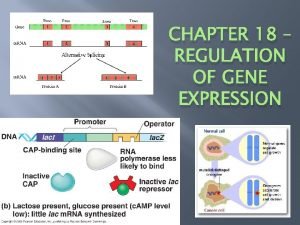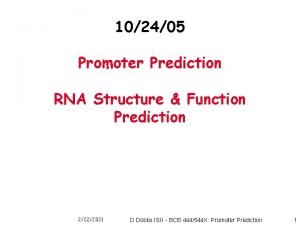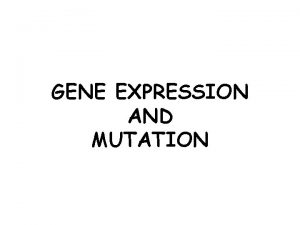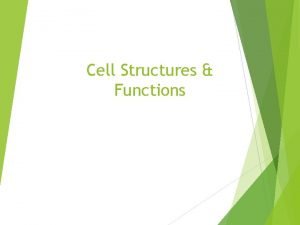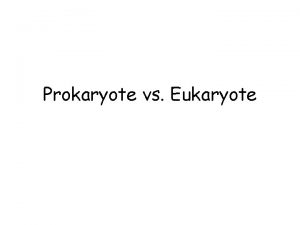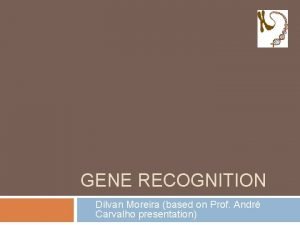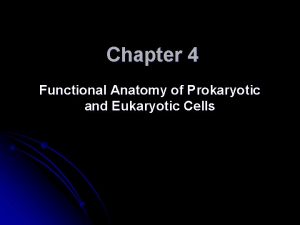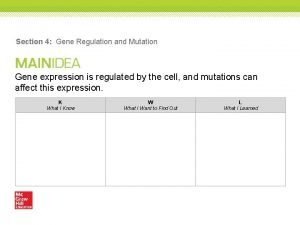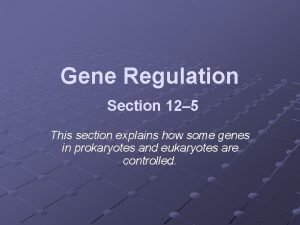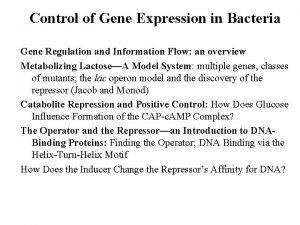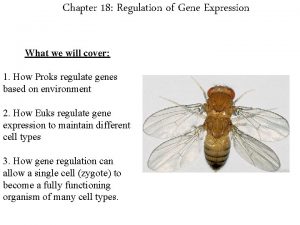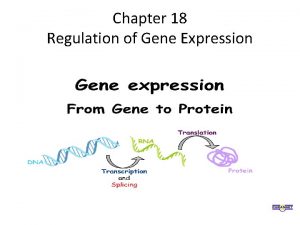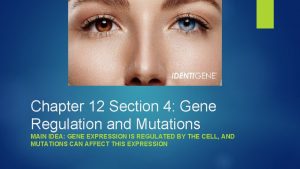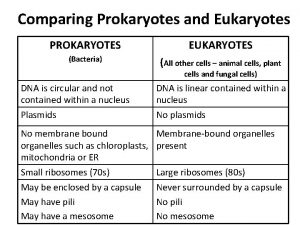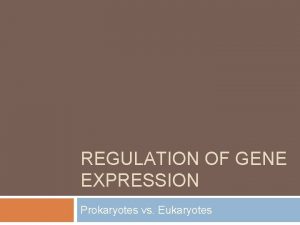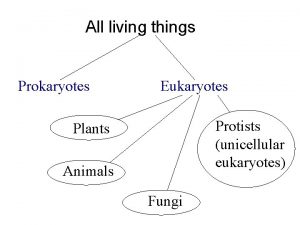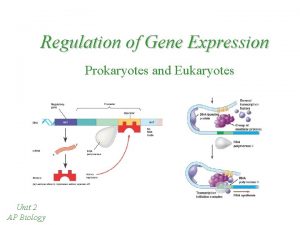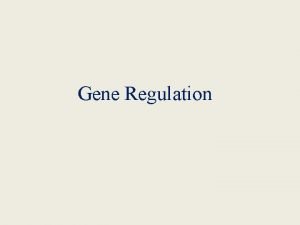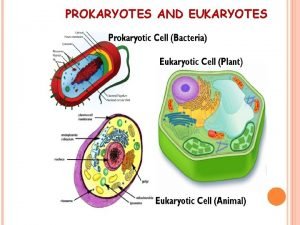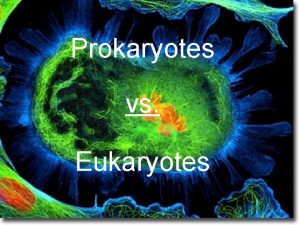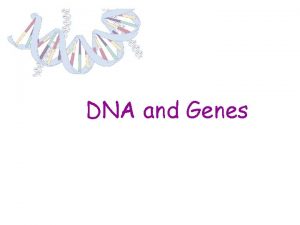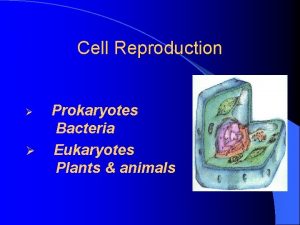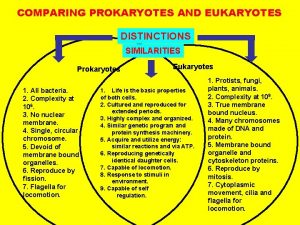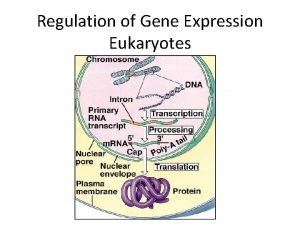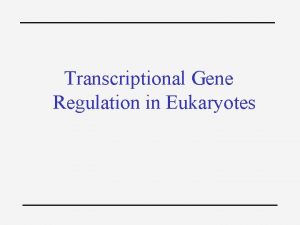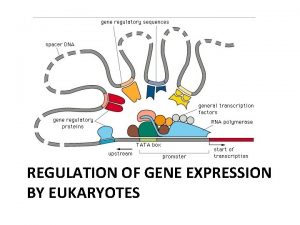Gene Control Prokaryotes vs Eukaryotes Gene regulation Two






















- Slides: 22

Gene Control Prokaryotes vs. Eukaryotes

Gene regulation § Two types of genes: 1)Structural genes – code specific proteins 2)Regulatory genes – control activity of structural genes (gene expression)

Gene regulation in prokaryotes § Operons control rate of transcription. § group of genes working together code for enzymes regulating specific metabolic pathway. OPERON Regulator gene Produces the repressor Promoter Operator RNA polymerase Repressor binding site Structural gene A Structural gene B

The Operon Model n Operon – group of genes with related functions n Genes – code for specific proteins Promoter – RNA pol binding site n – controls transcription of ALL genes in operon – Single m. RNA produced These 3 make up an operon! n Operator – binding site of repressor protein (turns off gene)

Quick Review in Metabolic regulation n Allosteric inhibitors – provide feedback inhibition (enzyme regulators) n Product of pathway signals continuation of path to STOP n Making all these enzymes is wasteful

Induction: Ex-The Lac Operon Repressor protein **NO lactose present** RNA Polymerase Codes for Regulator gene Promoter Operator 1 2 3 *Presence or absence of lactose regulates production of enzymes from structural genes of the lac operon*

**Lactose present** Lactose molecules Repressor protein Codes for Regulator gene Promoter Operator 1 2 3 Lactose is an inducer *Why do cells have these “on/off” switches? *

Repression: Ex – Tryp operon Excess tryptophan present, binds to tryp repressor protein triggering repressor to bind to DNA – blocks (represses) transcription – tend to be anabolic pathways n RNA polymerase RNA trp repressor TATA polymerase gene 1 gene 2 gene 3 gene 4 1 2 3 4 m. RNA enzyme 1 promoter enzyme 2 enzyme 3 DNA trp enzyme 4 operator trp repressor Tryp is an effector - activates repressor protein trp trp repressor tryptophan trp tryptophan – repressor protein complex

Gene regulation in prokaryotes - summary § Genes for metabolic pathways linked together in operons with a common switch mechanism (operator). § No introns – no RNA processing § Structural genes undergo transcription & translation simultaneously. § Regulation occurs by switching all genes of a pathway on or off.

What about Eukaryotes? How are they different? What might the process have to accommodate for? How might it do this? Eukaryotes often multicellular Battle changing environment Must maintain homeostasis Coordinate body as a whole Differentiated & specialized cells

When does gene control occur? ? ? 1. 2. 3. 4. 5. 6. Packing/unpacking DNA Transcription m. RNA processing Translation Protein processing Protein degradation

1. DNA Packing If all 46 of your chromosomes were lined up in a row, your DNA would be over 3 feet long. How can your cells contain this large amount of material when cells are microscopic? n Coils & Folds – – – Double helix Nucleosomes Chromatin fiber Looped domains Chromosomes from DNA double helix to condensed chromosome

n Degree of DNA packing regulates transcription – Tightly packed = no transcription = genes OFF n “Dark” DNA = tight n “Light” DNA = loose

n Repressors - (ex: adding -CH 3’s) block transcription factors no transcription genes OFF! n Activators (ex: adding –COCH 3’s) unwind DNA coils loosen transcription genes ON!

2. Transcription Initiation n Control regions on DNA – Promoter nearby control sequence – “standard” rate n bind RNA pol n bind transcription factors n – Enhancer distant control sequence – “enhanced” rate n bind activator proteins n

Transcription complex… Activator Proteins • regulatory proteins bind to DNA at Enhancer Sites distant enhancer sites • increase the rate of transcription regulatory sites on DNA distant from gene Activator Coactivator A E F B H TFIID T A RNA polymerase II Coding re gion Core promoter and initiation complex Initiation Complex - transcrip activated when “hairpin loop” brings TF’s on enhancer sequence (activators) to TF’s bound to RNA pol on promoter protein-protein interactions KEY!

3. Post-transcriptional control n Alternate splicing pattern – ↑ variation in protein family

4. Regulation of m. RNA degradation n Lifespan of m. RNA controls amt of protein synthesized – m. RNA can last from hrs to weeks!

What if degradation is interfered with? ? ? RNAi Small interfering RNAs (si. RNA) �short RNA (21 -28 bases) bind to m. RNA create sections of double-stranded m. RNA “death” tag for m. RNA triggers degradation �gene “silencing” post-transcriptional control turns off gene = no protein

5. Control of Translation n Block initiation of translation – Regulatory proteins attach to 5’ end n Prevent attachment of ribosome & initiator t. RNA n Synthesis turned OFF

6/7. Protein Processing & Degradation n Protein processing – Folding, cleaving, adding sugar groups, targeting for transport n Protein degradation – “death tags” (ubiquitin -76 aa’s) – Proteasomes – degradation machinery

Regulation Prokaryotes 1. Genes for metabolic pathways linked together in operons w/common switch mechanism (operator). 2. No introns - no RNA processing Eukaryotes 1. 2. Pathways separated, no operons. Genes switched on separately. 3. Structural genes undergo transcription & translation simultaneously. Introns on genes removed in RNA processing. 4. Transcription & translation do not occur simultaneously. 4. Regulation occurs by switching all genes in pathway on or off. 5. Large number of control elements.
 Lac operon inducible or repressible
Lac operon inducible or repressible Prokaryotes vs eukaryotes gene regulation
Prokaryotes vs eukaryotes gene regulation Gene prediction in prokaryotes and eukaryotes
Gene prediction in prokaryotes and eukaryotes Prokaryotic promoter vs eukaryotic promoter
Prokaryotic promoter vs eukaryotic promoter Venn diagram of plant and animal cells
Venn diagram of plant and animal cells Diff between prokaryotes and eukaryotes
Diff between prokaryotes and eukaryotes Prokaryotes and eukaryotes
Prokaryotes and eukaryotes Is protist a prokaryote or eukaryote
Is protist a prokaryote or eukaryote Eukarya
Eukarya Prokaryotes vs eukaryotes
Prokaryotes vs eukaryotes Multiple choice questions on prokaryotes and eukaryotes
Multiple choice questions on prokaryotes and eukaryotes Prokaryotic and eukaryotic cells chart
Prokaryotic and eukaryotic cells chart Polimerase
Polimerase Prokaryotic vs eukaryotic cells venn diagram
Prokaryotic vs eukaryotic cells venn diagram Which organisms are prokaryotes
Which organisms are prokaryotes Anatomy of prokaryotes and eukaryotes
Anatomy of prokaryotes and eukaryotes Lac operon positive control
Lac operon positive control Section 4 gene regulation and mutation
Section 4 gene regulation and mutation Section 12-5 gene regulation
Section 12-5 gene regulation Regulation of gene expression
Regulation of gene expression Chapter 18 regulation of gene expression
Chapter 18 regulation of gene expression Chapter 18 regulation of gene expression
Chapter 18 regulation of gene expression Section 4 gene regulation and mutation
Section 4 gene regulation and mutation

